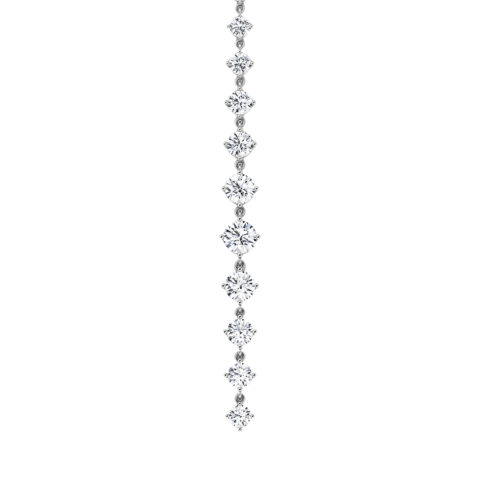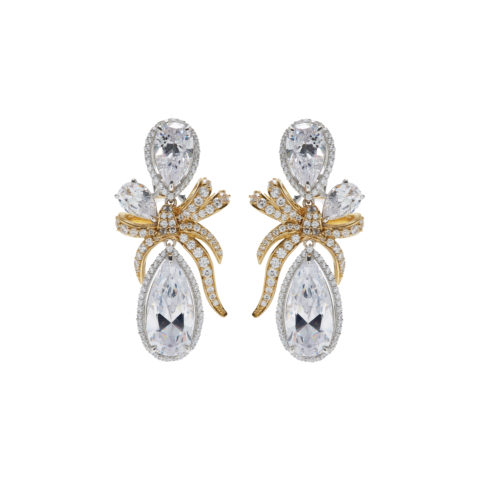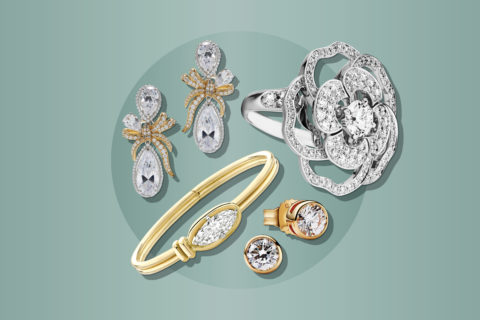The Lab-Grown vs. Natural Diamonds Debate
With both the natural- and lab-grown-diamond markets in flux, deciding which of these precious gems deserves a place in your collection can feel like rocky terrain.
Illustrious diamond collector Elizabeth Taylor reportedly once said that “jewellery has the power to be the one little thing that makes you feel unique.” It’s a statement that likely resonates with jewellery lovers, but it’s especially fitting given that no two diamonds are believed to be exactly the same. While Taylor was certainly well versed in the world of jewels, others may not realize that mined diamonds are also millions to billions of years old — a distinct quality that’s been valued for centuries.
However, the past decade or so has seen an unassailable shift. All of the magic and alchemy that creates diamonds within the earth’s mantle — where millennia of heat and pressure turn pure carbon into the world’s hardest naturally occurring material — can now be rapidly replicated, sometimes in a matter of weeks, in the form of lab-grown diamonds.
“Now, we’re seeing some companies with 80 per cent of their sales being in lab diamonds, when only five years ago, their business was 100 per cent natural diamonds,” says Donald A. Palmieri, an NYC-based industry expert and gemologist and the founder of Palmieri’s Market Monitor, a monthly trade compendium that publishes wholesale and auction gemstone market prices.
What’s old is new again
To be clear, lab diamonds have been around for quite a while — they first materialized in the 1950s but were mostly used for scientific purposes until recent years, when the consistency of their quality dramatically increased as their manufacturing costs simultaneously decreased, an ideal combination that left them primed for a major expansion into the consumer market.
Now, industry heavy hitters, including De Beers, Signet (which owns major brands such as Peoples and Blue Nile) and celebrity jeweller and Cartier-family descendant Jean Dousset (who has designed engagement rings for the likes of Amy Adams and Paris Hilton), have invested in the stones, which, not to be confused with diamond alternatives such as moissanites, are chemically and physically identical to natural diamonds. So no one can tell if your latest jaw-dropping bauble is a lab diamond or a natural diamond; in fact, only a gemological laboratory can identify them beyond a doubt.
“The industry has really taken a turn in the past 12 months, now that the natural-diamond market has lost its ultimate hold on engagement-ring sales; if a consumer is happy to accept a lab diamond for their engagement ring, they’ll also be happy to buy lab diamonds for every other piece of jewellery,” says Palmieri, who explains that it was only a few short years ago that the natural-diamond market saw a rare upsurge — during the pandemic, when consumers were busily spending an unexpected surplus of cash online.
With this swell in demand, natural-diamond prices actually went up — a potentially dangerous boom, it turns out, in the wake of the rise of readily available lab diamonds, which are currently selling wholesale at a mere fraction of the price of natural diamonds. In reality, diamonds, while precious and beautiful no matter what their price, have never been one of the rarest gems, and hence their relationship with the economic model of supply and demand is complex and hard to predict.
To (re)sell or not to sell…
While the prices of both lab and natural diamonds have experienced a record decline this year, the latter maintain their value in a way that lab diamonds have yet to prove in the secondary market — meaning that it’s always been possible to resell them, including on consignment or at public auction — a market that only continues to grow in popularity.
Just ask fans such as Drake and Kim K, who have both purchased high-profile jewels at auction, including those gems previously owned by Pharrell Williams and Tupac, in Drake’s case, and by Princess Diana, in Kim K’s case. (Tupac’s custom-made ruby and diamond ring alone set a record-breaking price for a hip-hop artifact of nearly $1,350,000.) On the flip side, the relative newness of lab diamonds, and their changing prices, means that a resale market may never materialize in quite the same way.
“Trends come and go, and the market may go up and down, but pieces from big historic houses such as Van Cleef & Arpels, Cartier and Tiffany continue to hold cachet,” says Kristin Kearney, director of Bonhams Canada. “People are always looking for those pieces, especially because they’re so well made.”
Kearney notes that truly rare coloured diamonds, such as fancy pinks and blues, and antique gems found in jewels from the perennially popular art deco and Edwardian periods are also considered marquee pieces that will often sustain and even increase in value over time. “Scarcity plays such a role in value, especially when it comes to antique cuts, like old mine-cut diamonds,” she says. “They have an extra appeal — an extra little sparkle that comes with a bit of a story. That’s what will always make them special.”
Size can be everything
In reality, antique cuts or the idea of natural diamonds being an ancient phenomenon may not resonate with everyone, especially those who have their heart set solely on a jaw-dropping Jennifer Lopez-worthy rock. In that vein, choosing a lab diamond with impeccable quality for a much more competitive price can be ideal for those who simply appreciate the unique beauty any diamond possesses — its striking and undeniable fire, scintillation and brilliance — regardless of whether it’s been sourced from the earth or is man-made.
After all, lab diamonds have already become a mainstay on the red carpet, worn by the likes of Rihanna, Billy Porter and Zendaya. Plus, for a piece that may require a plethora of diamonds, such as a timeless tennis necklace, more economical lab diamonds might just fit the bill.
Diamonds being more accessible in general is an idea that’s struck a chord with Danish brand Pandora, who decided to introduce its first lab diamonds in 2021 as a way of offering the gem to consumers who may have never considered such a luxurious purchase in the past.
“We are seeing a very broad interest in both existing and brand-new clients,” says Mary Carmen Gasco-Buisson, chief marketing officer for Pandora, which exclusively selects highly graded stones with VS clarity when sourcing lab-grown diamonds. “They love being able to add diamonds to their collection or even purchase a bigger diamond than they might have been able to before. Now we can make really high-quality jewellery accessible to everyone.”
Any diamond is forever
If you’re ultimately undecided on whether lab or natural diamonds are for you, Kearney says the first step is to consider your budget and define your priorities, including what will matter most in terms of size, quality and the idea of reselling in the future. Then, do your research: Go in person to a reputable dealer, a jewellery store or an auction house and try things on to consider the differences for yourself.
“It’s so important to shop for these special pieces in person because that’s ultimately how you’ll enjoy them,” Kearney advises. “Sometimes when we’re online, there’s so much information at our fingertips that it can be difficult to wade through the propaganda to determine what’s what.”
For example, take the controversial question of whether lab-grown diamonds are actually more environmentally friendly than those that have been mined. While many are eager to make claims for one side or the other, the reality is that it’s far too early to get a clear picture or form an educated opinion on a professed ideal, given the lack of timely research in an industry that includes strict government-enforced environmental guidelines, ethical mines, newly formed factories running around the clock on fossil fuels and carbon-footprint awareness at all levels.
It’s worth noting, however, that any piece of jewellery can be considered one of the most sustainable purchases you can make due to its imperishable nature and nearly infinite recyclability. Regardless of a fluctuating market or long-term predictions, all jewels are forever and can be adored for not only a lifetime but also many generations to come — a unique and shining quality that adds immeasurable value.
Get your glam on courtesy of these natural- and lab-grown-diamond showstoppers.
Pandora Era Bezel Lab-grown Diamond Stud Earrings

Jeweller: Pandora
Product details: 0.50 carat labgrown diamond and 14 karat gold earrings
Price: $940
Vrai Infinity Linked Tennis Bracelet

Jeweller: Vrai
Product details: 1.70 carats of labgrown diamonds and 14 karat white gold bracelet
Price: $3,945
Louis Vuitton Blossom Open Ring

Jeweller: Louis Vuitton
Product details: 0.33 carats of diamonds and 18 karat white gold ring
Price: $8,400
Cartier Juste un Clou Necklace

Jeweller: Cartier
Product details: 0.12 carats of diamonds and 18 karat white gold necklace
Price: $6,450
Chanel Bouton de Camélia Ring

Jeweller: Chanel
Product details: 0.39 carats of diamonds and 18 karat white gold ring
Price: Price upon request
Anabela Chan Multi-Stone Earrings

Jeweller and retailer: Anabela Chan at Moda Operandi
Product details: Labgrown diamond and 18 karat white and yellow gold vermeil earrings
Price: $4,970
Jessica McCormack Arbor Knot Bangle

Jeweller: Jessica McCormack
Product details: 2.50 carat diamond and 18 karat yellow gold bangle
Price: Price upon request
This article first appeared in FASHION’s Winter 2024 issue. Find out more here.
This article contains affiliate links, so we may earn a small commission when you make a purchase through links on our site at no additional cost to you.








